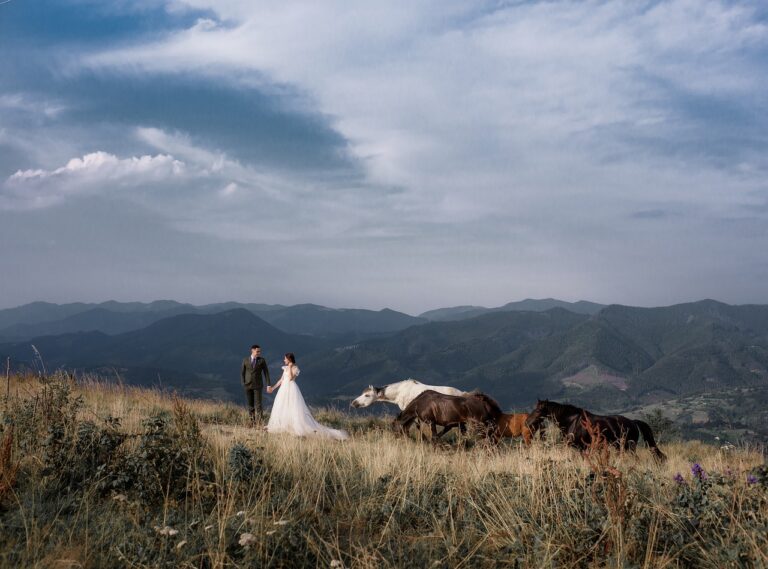It takes more than just arranging chairs in a row to plan outdoor ceremony seating on uneven ground. It entails working with the land rather than against it, much like when you carve a stage out of the natural contours of the land. This creative freedom turns into a chance for many couples to create something truly unique. There is an instant sense of coziness and warmth, especially when using rustic benches, which continue to be incredibly effective in grassy or wooded settings. Sturdy benches stabilize themselves with shared load, which makes them incredibly dependable on uneven surfaces, in contrast to fragile chairs that wobble with every change in weight.
When visitors include elderly family members or people who require assistance walking, this pragmatic approach becomes even more pertinent. Planners make sure a ceremony feels welcoming and comfortable without sacrificing its charm by incorporating well-considered layouts, such as cluster seating arranged around naturally occurring flat areas. This tactic is widely used in the Redwoods wedding trend, which is supported by environmentally conscious celebrities like Shailene Woodley. Intimate pods that feel reverent and grounded are created by seating arranged around tall trees.
For good reason, curved layouts like spirals and semicircles are becoming more popular; they provide a common focal point while deftly adjusting to uneven terrain. A spiral can be used to wrap around obstacles instead of arranging rows that slope randomly, which will maximize guest interaction and highlight the couple. At sunset ceremonies along the Pacific Coast, where winding aisle paths fully utilize the edges of the ocean cliffs, this technique has been particularly popular.
Outdoor Ceremony Seating Arrangements for Uneven Terrain
| Key Element | Practical Detail |
|---|---|
| Terrain Type | Grassy, rocky, sloped, or mixed; influences furniture choice and setup |
| Seating Options | Benches, clustered chairs, curved rows, or modular platforms depending on terrain |
| Guest Accessibility | Prioritize walkways, ramps, and low-sink flooring for mobility-impaired guests |
| Aesthetic Shapes | Semi-circles, spirals, quadrants, and horizontal aisles to enhance inclusivity and visibility |
| Adaptability Needs | Lightweight seating, movable shade, and last-minute rearrangement potential |
| Weather Considerations | Tents, sunshades, or windbreaks to support comfort and safety during unpredictable conditions |
| Celebrity Inspiration | Outdoor layouts used by Solange Knowles, Priyanka Chopra, and Kristen Bell as design references |
| Planning Tools | Site-mapping apps, on-site walk-throughs, or professional consultation before finalizing layout |
| Focal Point Positioning | Align views with natural backdrops like trees, lakes, or floral arches to elevate photo potential |
In addition to being aesthetically pleasing, benches and circular layouts are noticeably better choices for terrains with gradient shifts. Imagine the seating arrangement from Solange Knowles’ outdoor ceremony, where the seats organically curved around the room, fostering a feeling of community without sacrificing style. These decisions seem impromptu, but they are executed very effectively. Additionally, they take stunning pictures, providing each guest with an almost direct line of sight—an underappreciated benefit for an event this intimate.
Platforms have subtly emerged as the preferred option for people navigating very difficult terrain. Without sacrificing the outdoor atmosphere, elevated flooring—particularly modular platforms composed of wood or recycled composites—allows for completely level seating. These platforms turn functionality into aesthetic elegance when draped in neutral linens or adorned with trailing greens at prestigious vineyard weddings in California and Italy. This design guarantees that stability doesn’t come at the expense of style, even when used under a tent.
Creating an aisle through uneven terrain creates opportunities for incredibly creative walkway designs. Although it may seem unusual, a horizontal aisle that runs from left to right instead of front to back improves visibility and significantly lessens the effect of changes in terrain height. For instance, a couple at a lakeside wedding close to Asheville decided on a curved entrance that led guests past wildflowers to a panoramic altar area. Both the camera and the eye found the effect to be cinematic.
There is also a slight increase in the popularity of scattered seating, which involves placing chairs loosely throughout a field or grove. This approach, which was inspired by casual gatherings and nature retreats, lets visitors take up residence wherever they feel most at ease. This method significantly enhances the ambiance, particularly when paired with plush picnic blankets or poufs for younger guests. More significantly, this configuration avoids the rigidity of fixed alignment by easily accommodating terrain variation.
Instead of forcing symmetrical patterns onto uneven surfaces, wedding designers like Mindy Rice frequently stress the value of tailoring layout concepts to the land. Couples can identify the parts of their venue that are best for seating, stage setups, or areas with shade by forming strategic alliances with local planners or terrain experts. These partnerships have been especially helpful in recent years for destination weddings, particularly in Tuscany and the Caribbean, where stunning views are frequently combined with rugged landscapes.
Quadrant seating is another particularly advantageous strategy. In order to do this, the area must be divided into four equal blocks centered on an altar. It makes for a surprisingly dynamic experience, encourages movement, and lets guests watch the ceremony from various perspectives. It also divides the group into smaller, more manageable groups for larger gatherings, which lowers noise levels and promotes intimacy in spite of the crowd.
Modularity in the arrangement, such as movable chairs, lightweight benches, and adjustable parasols, allows for flexibility in changing as needed. Last year, these modular tools were incredibly helpful during a ceremony in Utah where a changing wind force necessitated a last-minute rearranging of half the seating just before vows started. The couple handled the changeover with ease, keeping the guests in the dark because they had prepared with flexibility in mind.
Many contemporary couples are choosing environmentally friendly furniture that is sourced sustainably and can more gracefully traverse uneven terrain. Repurposed wine barrels, bamboo seating, and benches made of recycled wood serve as both structural and decorative elements. In ceremonies held in gardens and forests, where guests are surrounded by living design elements, these selections are especially creative.

